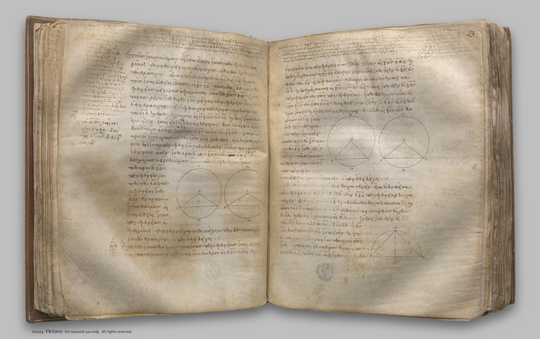index prev next | digilib folio 63

In equal circles equal circumferences are subtended by equal straight lines.
| Ἐν τοῖς ἴσοις κύκλοις τὰς ἴσας περιφερείας ἴσαι εὐθεῖαι ὑποτείνουσιν. Ἔστωσαν ἴσοι κύκλοι οἱ ΑΒΓ, ΔΕΖ, καὶ ἐν αὐτοῖς ἴσαι περιφέρειαι ἀπειλήφθωσαν αἱ ΒΗΓ, ΕΘΖ, καὶ ἐπεζεύχθωσαν αἱ ΒΓ, ΕΖ εὐθεῖαι: λέγω, ὅτι ἴση ἐστὶν ἡ ΒΓ τῇ ΕΖ. Εἰλήφθω γὰρ τὰ κέντρα τῶν κύκλων, καὶ ἔστω τὰ Κ, Λ, καὶ ἐπεζεύχθωσαν αἱ ΒΚ, ΚΓ, ΕΛ, ΛΖ. Καὶ ἐπεὶ ἴση ἐστὶν ἡ ΒΗΓ περιφέρεια τῇ ΕΘΖ περιφερείᾳ, ἴση ἐστὶ καὶ γωνία ἡ ὑπὸ ΒΚΓ τῇ ὑπὸ ΕΛΖ. καὶ ἐπεὶ ἴσοι εἰσὶν οἱ ΑΒΓ, ΔΕΖ κύκλοι, ἴσαι εἰσὶ καὶ αἱ ἐκ τῶν κέντρων: δύο δὴ αἱ ΒΚ, ΚΓ δυσὶ ταῖς ΕΛ, ΛΖ ἴσαι εἰσίν: καὶ γωνίας ἴσας περιέχουσιν: βάσις ἄρα ἡ ΒΓ βάσει τῇ ΕΖ ἴση ἐστίν. Ἐν ἄρα τοῖς ἴσοις κύκλοις τὰς ἴσας περιφερείας ἴσαι εὐθεῖαι ὑποτείνουσιν: ὅπερ ἔδει δεῖξαι. | In equal circles equal circumferences are subtended by equal straight lines. Let ABC, DEF be equal circles, and in them let equal circumferences BGC, EHF be cut off; and let the straight lines BC, EF be joined; I say that BC is equal to EF. For let the centres of the circles be taken, and let them be K, L; let BK, KC, EL, LF be joined. Now, since the circumference BGC is equal to the circumference EHF, the angle BKC is also equal to the angle ELF. [III. 27] And, since the circles ABC, DEF are equal, the radii are also equal; therefore the two sides BK, KC are equal to the two sides EL, LF; and they contain equal angles; therefore the base BC is equal to the base EF. [I. 4] |